Flu Vaccine Market
Flu Vaccine Market Size and Share Forecast Outlook 2025 to 2035
Flu vaccine market is projected to grow from USD 7,630.5 million in 2025 to USD 10,868.0 million by 2035, at a CAGR of 3.6%. Quadrivalent will dominate with a 68.4% market share, while adults will lead the age group segment with a 56.7% share.
Flu Vaccine Market Forecast and Outlook 2025 to 2035
The global flu vaccine market is forecasted to reach USD 10,950.8 million by 2035, recording an absolute increase of USD 3,320.3 million over the forecast period. The market is valued at USD 7,630.5 million in 2025 and is set to rise at a CAGR of 3.6% during the assessment period.
The overall market size is expected to grow by approximately 1.4 times during the same period, supported by increasing demand for comprehensive influenza prevention worldwide, driving demand for annual vaccination programs and increasing investments in vaccine manufacturing facilities and public health initiatives globally. The seasonal demand fluctuations and manufacturing capacity constraints may pose challenges to market expansion.
Quick Stats for Flu Vaccine Market
- Flu Vaccine Market Value (2025): USD 7,630.5 million
- Flu Vaccine Market Forecast Value (2035): USD 10,950.8 million
- Flu Vaccine Market Forecast CAGR: 3.6%
- Leading Vaccine Type in Flu Vaccine Market: Quadrivalent
- Key Growth Regions in Flu Vaccine Market: North America, Europe, and Asia Pacific
- Top Players in Flu Vaccine Market: Sanofi Pasteur, GlaxoSmithKline (GSK), Seqirus (CSL Limited), AstraZeneca (FluMist), Moderna, Pfizer, Daiichi Sankyo, Sinovac Biotech, Bharat Biotech, Serum Institute of India, Biondvax Pharmaceuticals, Valneva SE, Novavax, BioDiem, Medicago
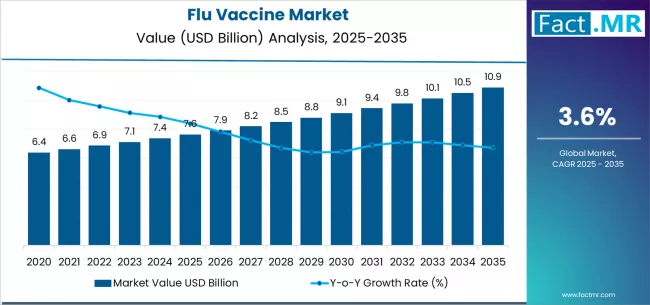
Flu Vaccine Market Year-over-Year Forecast 2025 to 2035
Between 2025 and 2030, the market is projected to expand from USD 7,630.5 million to USD 9,150.0 million, resulting in a value increase of USD 1,519.5 million, which represents 45.8% of the total forecast growth for the decade. This phase of development will be shaped by rising demand for enhanced influenza protection and multi-strain coverage, product innovation in adjuvanted vaccines and cell-based manufacturing platforms, as well as expanding integration with public health programs and annual vaccination campaigns. Companies are establishing competitive positions through investment in vaccine research and development, manufacturing scale-up technologies, and strategic market expansion across healthcare systems, pharmacies, and government programs.
From 2030 to 2035, the market is forecast to grow from USD 9,150.0 million to USD 10,950.8 million, adding another USD 1,800.8 million, which constitutes 54.2% of the overall ten-year expansion. This period is expected to be characterized by the expansion of next-generation vaccine technologies, including universal flu vaccines and mRNA-based platforms tailored for rapid strain adaptation, strategic collaborations between vaccine manufacturers and public health organizations, and an enhanced focus on pandemic preparedness and manufacturing resilience. The growing focus on global vaccination coverage and strain effectiveness will drive demand for innovative flu vaccine solutions across diverse healthcare applications.
Flu Vaccine Market Key Takeaways
| Metric | Value |
|---|---|
| Market Value (2025) | USD 7,630.5 million |
| Market Forecast Value (2035) | USD 10,950.8 million |
| Forecast CAGR (2025-2035) | 3.6% |
Why is the Flu Vaccine Market Growing?
The flu vaccine market grows by enabling healthcare systems and individuals to optimize influenza prevention while accessing comprehensive protection against seasonal flu strains without substantial infection risks. Healthcare providers and public health authorities face mounting pressure to reduce flu-related hospitalizations and comply with vaccination coverage targets, with modern flu vaccines typically providing 40-60% efficacy rates when well-matched to circulating strains, making annual vaccination programs essential for population health protection. The healthcare industry's need for integrated immunization systems and population-specific flu prevention creates demand for comprehensive vaccine solutions that can provide broad strain coverage, maintain consistent supply availability, and ensure program effectiveness without compromising safety or accessibility.
Government initiatives promoting vaccination programs and pandemic preparedness drive adoption in healthcare facilities, pharmacies, and community settings, where flu vaccines have a direct impact on public health outcomes and healthcare system capacity. The seasonal production constraints and strain prediction challenges may limit vaccine effectiveness and availability among certain populations and regions with complex distribution requirements for comprehensive immunization programs.
Segmental Analysis
The market is segmented by vaccine type, age group, distribution channel, and region. By vaccine type, the market is divided into quadrivalent and trivalent vaccines. Based on age group, the market is categorized into adults, pediatrics, and geriatrics. By distribution channel, the market includes hospitals & clinics, pharmacies & retail chains, and government/public programs. By region, the market is divided into North America, Europe, Asia Pacific, Rest of World.
By Vaccine Type, the Quadrivalent Segment Accounts for a Dominant Market Share
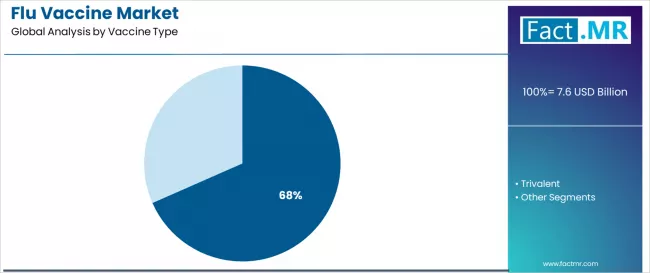
The quadrivalent segment represents the dominant force in the flu vaccine market, capturing approximately 68.4% of total market share in 2025. This established vaccine category encompasses solutions featuring protection against four influenza strains and comprehensive coverage capabilities, including two influenza A strains and two influenza B strains that enable superior protection across all demographic groups. The quadrivalent segment's market leadership stems from its superior coverage capabilities, with vaccines capable of providing broader strain protection while maintaining safety profiles and operational effectiveness across all vaccination programs.
The trivalent segment maintains a substantial 31.6% market share, serving populations that require cost-effective vaccination with established safety features for basic influenza protection and routine immunization programs. These vaccines offer reliable protection solutions for diverse applications while providing sufficient efficacy capabilities to meet public health requirements and program standards.
Key advantages driving the quadrivalent segment include:
- Enhanced strain coverage with integrated B-lineage protection that reduces influenza infection risks while ensuring comprehensive seasonal protection across diverse viral circulation patterns
- Broad demographic compatibility options allowing utilization across all age groups without significant safety or efficacy variations
- Improved public health outcomes, providing population-level protection while maintaining cost-effectiveness for large-scale vaccination programs
- Advanced formulation profiles enabling consistent annual production and distribution capabilities for global immunization requirements
By Age Group, the Adults Segment Accounts for the Largest Market Share
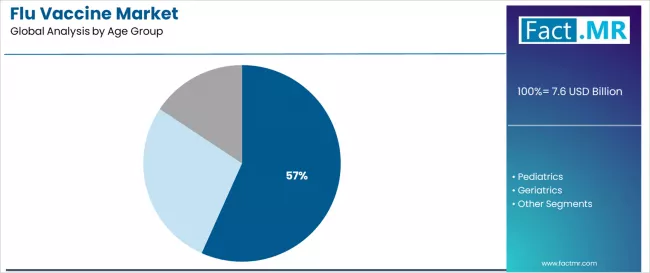
Adult vaccination applications dominate the market with approximately 56.7% market share in 2025, reflecting the critical role of workplace and community immunization in supporting comprehensive flu prevention and healthcare system protection worldwide. The adults segment's market leadership is reinforced by employer vaccination programs, healthcare worker requirements, and expanding adult immunization awareness in integrated public health initiatives across developed and emerging markets.
The pediatrics segment represents a substantial 27.5% market share, capturing school-age vaccination programs, pediatric healthcare requirements, and family immunization initiatives. This segment benefits from established childhood vaccination schedules that meet specific safety requirements, dosing protocols, and pediatric formulation standards in competitive healthcare markets.
The geriatrics segment accounts for 15.8% market share, serving high-risk elderly populations including nursing home residents, chronic disease patients, and age-related immunocompromised individuals across various healthcare sectors.
Key market dynamics supporting age group growth include:
- Adult vaccination expansion driven by workplace health programs and healthcare system requirements, requiring comprehensive immunization facilities in corporate and community settings
- Pediatric vaccination standardization trends require age-appropriate, safe formulations for efficacy consistency and parent acceptance
- Integration of geriatric care protocols enabling specialized dosing applications and enhanced protection systems for vulnerable populations
- Growing focus on population-wide coverage driving demand for comprehensive, age-specific vaccination solutions
By Distribution Channel, the Hospitals & Clinics Segment Accounts for the Largest Market Share
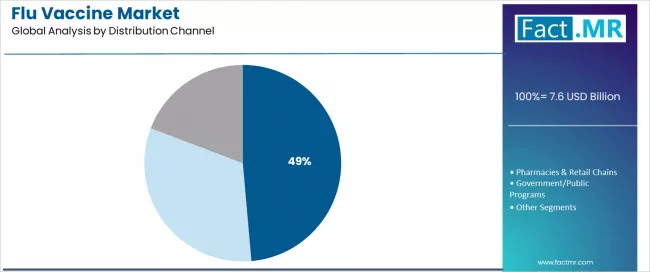
Hospitals & clinics distribution dominates the market with approximately 48.6% market share in 2025, reflecting the essential role of healthcare facilities in professional vaccination services and comprehensive immunization programs. The hospitals & clinics segment encompasses primary care vaccination, specialty clinic programs, and healthcare system-wide immunization initiatives that ensure proper administration and patient monitoring.
The pharmacies & retail chains segment represents a substantial 32.9% market share, capturing convenient community vaccination through pharmacy clinics, retail health centers, and accessible immunization services. This segment benefits from extended hours, convenient locations, and consumer preference for accessible vaccination options that integrate with routine healthcare activities.
The government/public programs segment accounts for 18.5% market share, serving mass vaccination campaigns, school-based programs, and public health initiatives across various governmental and community sectors.
What are the Drivers, Restraints, and Key Trends of the Flu Vaccine Market?
The market is driven by three concrete demand factors tied to public health outcomes. First, aging population demographics and increasing chronic disease prevalence create expanding demand for influenza prevention, with high-risk populations growing by 5-8% annually in major developed countries worldwide, requiring comprehensive vaccination infrastructure. Second, pandemic preparedness initiatives and healthcare system capacity protection drive increased adoption of annual vaccination programs, with many countries implementing universal vaccination goals for population immunity by 2030. Third, technological advancement in vaccine manufacturing and strain prediction enables more effective and timely vaccine production that improves match rates while enhancing protection efficacy and program reliability capabilities.
Market restraints include seasonal production challenges and strain mismatch risks that can reduce vaccine effectiveness in certain years, particularly when circulating virus strains differ significantly from vaccine formulations. Manufacturing capacity limitations and supply chain constraints pose another significant challenge, as annual vaccine production requires extensive advance planning and facility commitment, potentially causing distribution delays and coverage gaps. Cold chain requirements and storage complexity across different regions create additional logistical challenges for vaccine distribution, demanding ongoing investment in temperature-controlled logistics and professional handling programs.
Key trends indicate accelerated adoption in Asia-Pacific markets, particularly India and China, where expanding healthcare infrastructure and government vaccination programs drive comprehensive flu prevention adoption. Technology integration trends toward mRNA platforms with rapid strain adaptation, cell-based manufacturing, and improved adjuvant systems enable enhanced vaccine approaches that optimize protection effectiveness and manufacturing flexibility. The market thesis could face disruption if significant advances in antiviral treatments or major improvements in flu prediction accuracy reduce reliance on traditional annual vaccination strategies.
Analysis of the Flu Vaccine Market by Key Country
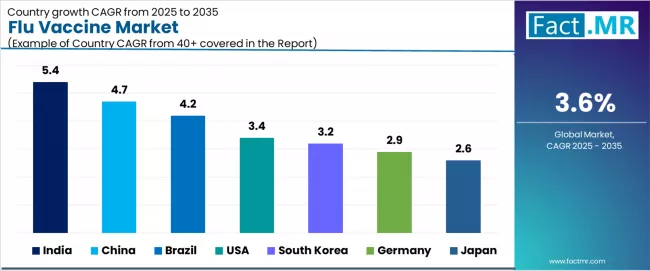
| Country | CAGR (2025-2035) |
|---|---|
| India | 5.4% |
| China | 4.7% |
| Brazil | 4.2% |
| United States | 3.4% |
| South Korea | 3.2% |
| Germany | 2.9% |
| Japan | 2.6% |
The market is projected to witness consistent expansion between 2025 and 2035, driven by public immunization initiatives, technological progress in vaccine formulations, and heightened pandemic preparedness. India leads growth with a 5.4% CAGR, supported by rising vaccination coverage and strong government procurement programs. China follows at 4.7%, aided by continuous development of quadrivalent and recombinant vaccines. Brazil maintains 4.2%, influenced by public health campaigns and expanding domestic production capacity. The United States grows at 3.4%, driven by ongoing awareness and adoption of advanced delivery systems. South Korea sustains 3.2%, reflecting improved cold-chain logistics. Germany records 2.9%, emphasizing preventive health policies, while Japan grows modestly at 2.6%, supported by seasonal flu awareness and aging population immunization drives.
India Leads Global Market Expansion
India demonstrates the strongest growth potential in the market with a CAGR of 5.4% through 2035. The country's leadership position stems from expanding healthcare infrastructure, government vaccination program development, and increasing public health awareness driving the adoption of comprehensive influenza prevention solutions. Growth is concentrated in major healthcare centers, including Delhi, Mumbai, Bangalore, and Chennai, where healthcare facilities and public health programs are implementing advanced vaccination services for enhanced disease prevention and population protection. Distribution channels through healthcare providers and government programs expand deployment across urban healthcare projects and rural immunization initiatives. The country's Universal Immunization Programme provides support for vaccine program expansion, including flu vaccine integration and healthcare infrastructure development.
Key market factors:
- Healthcare expansion concentrated in urban centers and rural health programs with comprehensive vaccination development initiatives
- Government support through public health programs and immunization coverage expansion plans
- Comprehensive vaccination ecosystem development, including established vaccine distributors with proven public health track records
- Technology integration featuring cold chain management systems, digital tracking platforms, and population coverage optimization technologies
China Emerges as High-Growth Market
In Beijing, Shanghai, Guangzhou, and Shenzhen, the adoption of comprehensive flu vaccination programs is accelerating across healthcare systems and community health centers, driven by government health policy targets and public health modernization programs. The market demonstrates strong growth momentum with a CAGR of 4.7% through 2035, linked to comprehensive healthcare system development and increasing focus on preventive medicine solutions. Chinese healthcare systems are implementing advanced vaccination programs and integrated health management platforms to enhance population protection while meeting demands of growing health consciousness and government disease prevention initiatives. The country's Healthy China initiatives create demand for comprehensive solutions, while increasing focus on preventive healthcare drives adoption of population-wide vaccination systems.
Key development areas:
- Healthcare facilities and community health centers leading vaccination program adoption with comprehensive modernization initiatives
- Public health supply chain channels providing integrated solutions with 75% coverage improvement rates
- Government partnerships between healthcare systems and vaccine manufacturers are expanding program reach
- Integration of digital health technologies and comprehensive population health management systems
Brazil Shows Strong Regional Leadership
Brazil's market expansion is driven by diverse public health demand, including vaccination program expansion in São Paulo and health system development in Rio de Janeiro, and comprehensive immunization adoption across multiple states. The country demonstrates promising growth potential with a CAGR of 4.2% through 2035, supported by federal government health programs and state-level public health development initiatives. Brazilian health systems face implementation challenges related to distribution infrastructure and vaccine affordability, requiring expanded government funding and support from international health organizations. Growing disease prevention awareness and public health requirements create compelling business cases for vaccination adoption, particularly in regions where flu prevention has direct impact on healthcare system capacity and population health outcomes.
Market characteristics:
- Public health systems and urban population segments showing fastest growth with 15% annual increase in vaccination coverage
- Regional expansion trends focused on healthcare infrastructure development in major metropolitan and rural areas
- Future projections indicate need for expanded cold chain infrastructure and healthcare worker training programs
- Growing focus on preventive medicine and population health management in healthcare system operations
United States Demonstrates Market Maturity
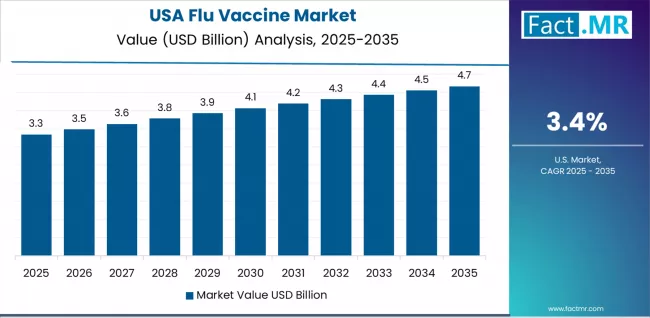
The U.S. market leads in comprehensive flu vaccination infrastructure based on integration with healthcare insurance systems and established immunization networks for enhanced program delivery performance. The country shows strong potential with a CAGR of 3.4% through 2035, driven by the expansion of pharmacy-based vaccination services and healthcare system integration in major demographic areas, including California, Texas, Florida, and New York. American healthcare systems are adopting advanced vaccination management for coverage optimization and outcome improvement, particularly in regions with established pharmacy networks and healthcare integration demanding comprehensive immunization coordination. Service delivery channels through healthcare providers and retail pharmacies expand coverage across community health centers and workplace vaccination programs.
Leading market segments:
- Healthcare system vaccination programs and pharmacy-based services are driving comprehensive flu prevention expansion
- Insurance integration partnerships with vaccination providers, achieving 80% population coverage improvement rates
- Strategic collaborations between healthcare organizations and vaccine manufacturers are expanding market presence
- Focus on high-performance distribution systems and specialized population health requirements
South Korea Shows Technology Integration Growth
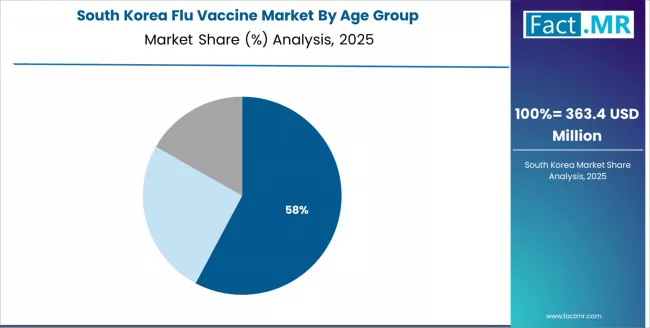
In Seoul, Busan, Daegu, and Incheon, healthcare systems are implementing comprehensive flu vaccination solutions to integrate with digital health platforms and population health monitoring, with documented case studies showing 35% improvement in vaccination coverage through technology-enhanced programs. The market shows strong growth potential with a CAGR of 3.2% through 2035, linked to ongoing digital health expansion, vaccination program modernization, and emerging connected healthcare projects in major regions. Korean healthcare systems are adopting intelligent vaccination management and tracking platforms to enhance program effectiveness while maintaining integration with national health information systems and disease surveillance networks. The country's established digital health infrastructure creates demand for advanced vaccination solutions that integrate with existing population health and disease prevention systems.
Market development factors:
- Healthcare systems and digital health facilities leading vaccination program adoption with comprehensive technology integration
- Digital health modernization programs providing government support for vaccination infrastructure and technology development
- Strategic partnerships between Korean healthcare companies and international vaccine providers are expanding technical capabilities
- Focus on digital integration and population health tracking across healthcare applications
Germany Prioritizes Quality Program Standards
Germany's market demonstrates sophisticated implementation focused on healthcare quality standards and insurance integration, with documented integration of comprehensive vaccination programs achieving 25% improvement in coverage outcomes across healthcare facilities and community programs. The country maintains steady growth momentum with a CAGR of 2.9% through 2035, driven by healthcare systems' focus on quality standards and program coordination methodologies that align with German healthcare requirements applied to vaccination operations. Major population centers, including Berlin, Munich, Hamburg, and Frankfurt, showcase advanced deployment of vaccination programs where healthcare services integrate seamlessly with existing insurance coverage systems and comprehensive population health management programs.
Key market characteristics:
- Healthcare systems and community health programs are driving advanced vaccination requirements with focus on quality assurance and coverage optimization
- Insurance integration partnerships enabling 92% coverage compliance with comprehensive vaccination programs
- International collaboration between German healthcare providers and vaccine manufacturers is expanding market capabilities
- Focus on evidence-based medicine and quality healthcare delivery methodologies
Japan Emphasizes Advanced Program Coordination
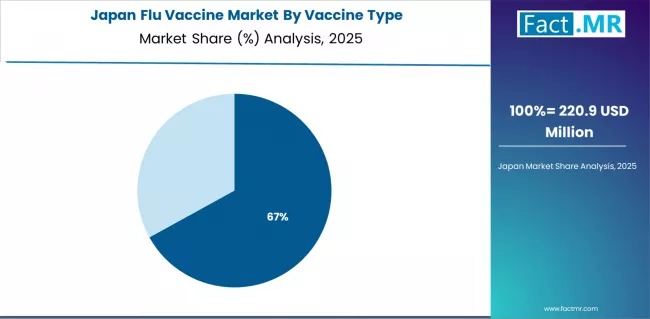
Japan's market demonstrates mature and technology-integrated landscape, characterized by sophisticated coordination of vaccination programs with existing healthcare infrastructure across medical facilities, community health centers, and elderly care networks. Japan's focus on aging population protection and healthcare system efficiency drives demand for high-quality vaccination solutions that support comprehensive public health initiatives and population coverage requirements in healthcare operations. The market benefits from strong partnerships between international vaccine providers and domestic healthcare organizations, creating comprehensive immunization ecosystems that prioritize program effectiveness and population health outcomes. Healthcare centers in major population regions showcase advanced vaccination implementations where public health programs achieve 85% coverage rates through integrated health management systems.
In Japan, quadrivalent vaccines dominate with 70.2% market share, while trivalent vaccines maintain 29.8%, reflecting the country's preference for comprehensive strain protection and advanced vaccine formulations in flu prevention programs.
In South Korea, hospitals & clinics lead distribution with 51.5% market share, followed by pharmacies & retail chains at 29.4% and government/public programs at 19.1%, demonstrating the continued importance of healthcare facility-based vaccination in program delivery.
Europe Market Split by Country
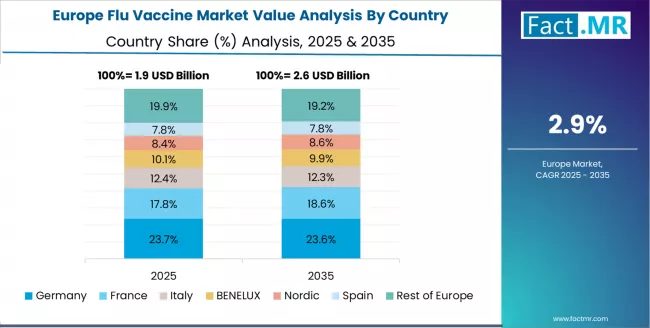
The flu vaccine market in Europe demonstrates steady growth supported by established healthcare systems and comprehensive vaccination programs across major regional markets. Germany maintains its leadership position with a 21.7% market share in 2025, supported by its extensive healthcare infrastructure, advanced vaccination facilities, and comprehensive immunization reimbursement systems serving diverse population needs.
United Kingdom follows with a 17.2% share in 2025, driven by NHS vaccination programs and private healthcare expansion implementing comprehensive flu prevention initiatives. France holds a 16.4% share through ongoing development of public health facilities and vaccination networks. Italy commands a 12.9% share, while Spain accounts for 10.8% in 2025. The Rest of Europe region represents 21.0% of the market, attributed to flu vaccination adoption across Nordic countries and emerging Eastern European healthcare facilities implementing modern immunization programs.
Competitive Landscape of the Flu Vaccine Market
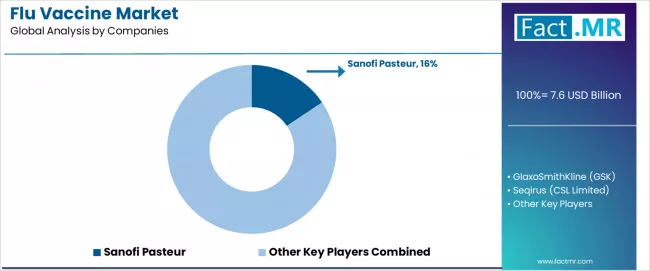
The market features approximately 20-30 meaningful players with moderate concentration, where the top three companies control roughly 40-50% of global market share through established vaccine portfolios and extensive healthcare relationships. Competition centers on strain coverage, manufacturing capacity, and distribution efficiency rather than price competition alone.
Market leaders include Sanofi Pasteur with 15.6% market share, along with GlaxoSmithKline (GSK), Seqirus (CSL Limited), and AstraZeneca (FluMist), which maintain competitive advantages through comprehensive vaccine solution portfolios, global manufacturing networks, and deep expertise in the influenza vaccine and immunization sectors, creating established relationships with healthcare systems and public health organizations. These companies leverage proven manufacturing capabilities and regulatory expertise to defend market positions while expanding into adjacent vaccine development and pandemic preparedness applications.
Challengers encompass emerging mRNA technology companies including Moderna, which compete through next-generation vaccine platforms and rapid development capabilities. Established pharmaceutical companies including Pfizer and Daiichi Sankyo focus on specific technologies or regional markets, offering differentiated capabilities in adjuvanted vaccines, manufacturing scale, and market access expertise.
Regional vaccine manufacturers including Sinovac Biotech, Bharat Biotech, and Serum Institute of India create competitive pressure through cost-effective production and local market expertise, particularly in high-growth markets where regional presence provides advantages in regulatory compliance and government program participation.
Global Flu Vaccine Market - Stakeholder Contribution Framework
Flu vaccine solutions represent a critical public health technology that enables healthcare systems, governments, and individuals to prevent seasonal influenza while maintaining population health and healthcare system capacity without substantial disease burden. With the market projected to grow from USD 7,630.5 million in 2025 to USD 10,950.8 million by 2035 at a 3.6% CAGR, these solutions offer compelling advantages including disease prevention, reduced hospitalizations, and economic protection, making them essential for public health systems (established programs), pandemic preparedness (expanding focus), and diverse population applications seeking reliable influenza protection. Scaling market penetration and vaccination capabilities requires coordinated action across public health policy, immunization standards, vaccine manufacturers, healthcare providers, and international health organizations.
How Governments Could Spur Local Production and Adoption?
- Public Health Infrastructure Programs: Include vaccination capabilities in national disease prevention initiatives, providing targeted funding for immunization programs in underserved regions and supporting vaccine manufacturing through development incentives and capacity building support.
- Tax Policy & R&D Support: Implement accelerated depreciation schedules for vaccine manufacturing equipment, provide tax incentives for companies investing in advanced vaccine technologies and mRNA platforms, and establish favorable research accounting standards that encourage innovative vaccine development over traditional approaches.
- Regulatory Framework Development: Create streamlined vaccine approval processes for seasonal strain updates across public and private distribution channels, establish clear efficacy testing frameworks for annual vaccine operation, and develop international harmonization protocols that facilitate cross-border vaccine distribution and supply coordination.
- Skills Development & Training: Fund medical programs for vaccination specialists, public health professionals, and healthcare workers. Invest in technology transfer initiatives that bridge academic research with commercial vaccine development and distribution optimization systems.
- Market Access & Competition: Establish procurement policies that ensure vaccine accessibility for government healthcare programs, support public-private partnerships for vaccine distribution through preferential contracting programs, and create regulatory environments that encourage innovation in vaccine technologies and delivery methods.
How Industry Bodies Could Support Market Development?
- Quality Standards & Certification: Define standardized performance metrics for vaccine efficacy across quadrivalent and trivalent applications, establish universal safety and distribution protocols, and create certification programs for vaccine effectiveness that healthcare providers and patients can rely upon.
- Market Education & Best Practices: Lead messaging that demonstrates vaccination advantages, emphasizing improved population health outcomes, reduced healthcare costs, and superior disease prevention compared to treatment-only approaches.
- Distribution Integration Standards: Develop interoperability standards for vaccine distribution systems, cold chain compatibility guidelines, and public health platforms, ensuring seamless integration across different healthcare environments and population requirements.
- Professional Development: Run certification programs for healthcare workers, vaccination specialists, and public health staff on optimizing vaccine administration, population coverage coordination, and outcome measurement in competitive healthcare markets.
How Manufacturers and Technology Players Could Strengthen the Ecosystem?
- Advanced Vaccine Development: Develop next-generation vaccines with enhanced strain coverage capabilities, improved manufacturing speed, and application-specific formulations that enhance protection reliability while reducing production timelines and distribution complexity.
- Intelligence Platforms: Provide comprehensive distribution software that integrates supply chain management, cold chain monitoring, population tracking, and efficacy assessment, enabling healthcare systems to maximize vaccination coverage and program effectiveness.
- Service & Support Networks: Offer flexible support programs for healthcare systems and distribution networks, including professional training options, technical support services, and supply optimization pathways that keep vaccination programs current with population health demands.
- Research & Development Networks: Build comprehensive R&D capabilities, collaborative vaccine innovation programs, and rapid response development systems that ensure vaccine technologies maintain high efficacy rates and consistent performance across diverse viral strains and population environments.
How Healthcare Systems Could Navigate Vaccination Programs?
- Diversified Vaccine Portfolios: Expand vaccination offerings across quadrivalent vaccines (68.4% market dominance), adult populations (56.7% share), and hospital/clinic distribution (48.6% share), with particular focus on comprehensive coverage solutions and specialized formulations for individual population requirements.
- Geographic Program Development: Establish vaccination services in high-growth markets like India (5.4% CAGR) and China (4.7% CAGR), while strengthening programs in established markets like Brazil (4.2% CAGR) and United States (3.4% CAGR) through regional distribution capabilities and community partnerships.
- Technology-Enabled Distribution: Implement advanced tracking systems with real-time inventory monitoring, population coverage assessment, and efficacy tracking features that improve program transparency and vaccination outcomes.
- Flexible Service Models: Develop standard, premium, and specialized vaccination programs that accommodate varying population needs, from basic seasonal protection to comprehensive high-risk population coverage for demanding public health situations.
How Investors and Financial Enablers Could Unlock Value?
- Vaccine Technology Expansion Financing: Provide growth capital for established companies like Sanofi Pasteur, GSK, and Seqirus to expand vaccine production capacity and geographic distribution, particularly in emerging markets with growing vaccination program demands.
- Innovation Investment: Back startups developing mRNA flu vaccines, rapid strain adaptation platforms, and universal flu vaccine technologies that enhance vaccine industry effectiveness and pandemic preparedness.
- Regional Market Development: Finance market entry and expansion strategies for vaccine companies establishing operations in high-growth regions, supporting manufacturing localization initiatives that reduce distribution costs while maintaining quality standards.
- Consolidation & Scale Opportunities: Support strategic acquisitions and market consolidation that create manufacturing efficiencies, improve vaccine distribution capabilities, and enhance competitive positioning against fragmented regional providers across multiple geographic markets.
Key Players in the Flu Vaccine Market
- Sanofi Pasteur 15.6
- GlaxoSmithKline (GSK)
- Seqirus (CSL Limited)
- AstraZeneca (FluMist)
- Moderna (mRNA Flu pipeline)
- Pfizer
- Daiichi Sankyo
- Sinovac Biotech
- Bharat Biotech
- Serum Institute of India
- Biondvax Pharmaceuticals
- Valneva SE
- Novavax
- BioDiem
- Medicago (Mitsubishi/Philip Morris JV)
Scope of the Report
| Items | Values |
|---|---|
| Quantitative Units | USD 7,630.5 million |
| Vaccine Type | Quadrivalent, Trivalent |
| Age Group | Adults, Pediatrics, Geriatrics |
| Distribution Channel | Hospitals & Clinics, Pharmacies & Retail Chains, Government/Public Programs |
| Regions Covered | North America, Europe, Asia Pacific, Rest of World |
| Country Covered | India, China, Brazil, USA, South Korea, Germany, Japan, and 40+ countries |
| Key Companies Profiled | Sanofi Pasteur, GlaxoSmithKline (GSK), Seqirus (CSL Limited), AstraZeneca, Moderna, Pfizer, Daiichi Sankyo, Sinovac Biotech, Bharat Biotech, Serum Institute of India, Biondvax Pharmaceuticals, Valneva SE, Novavax, BioDiem, Medicago |
Flu Vaccine Market by Segments
-
Vaccine Type:
- Quadrivalent
- Trivalent
-
Age Group:
- Adults
- Pediatrics
- Geriatrics
-
Distribution Channel:
- Hospitals & Clinics
- Pharmacies & Retail Chains
- Government/Public Programs
-
Region:
- North America
- United States
- Canada
- Mexico
- Europe
- Germany
- United Kingdom
- France
- Italy
- Spain
- Nordic
- BENELUX
- Rest of Europe
- Asia Pacific
- China
- Japan
- South Korea
- India
- Australia & New Zealand
- ASEAN
- Rest of Asia Pacific
- Rest of World
- Brazil
- Chile
- Rest of Latin America
- Kingdom of Saudi Arabia
- Other GCC Countries
- Turkey
- South Africa
- Other African Union
- Rest of Middle East & Africa
- North America
Table of Content
- Executive Summary
- Global Market Outlook
- Demand to side Trends
- Supply to side Trends
- Technology Roadmap Analysis
- Analysis and Recommendations
- Market Overview
- Market Coverage / Taxonomy
- Market Definition / Scope / Limitations
- Market Background
- Market Dynamics
- Drivers
- Restraints
- Opportunity
- Trends
- Scenario Forecast
- Demand in Optimistic Scenario
- Demand in Likely Scenario
- Demand in Conservative Scenario
- Opportunity Map Analysis
- Product Life Cycle Analysis
- Supply Chain Analysis
- Investment Feasibility Matrix
- Value Chain Analysis
- PESTLE and Porter’s Analysis
- Regulatory Landscape
- Regional Parent Market Outlook
- Production and Consumption Statistics
- Import and Export Statistics
- Market Dynamics
- Global Market Analysis 2020 to 2024 and Forecast, 2025 to 2035
- Historical Market Size Value (USD Million) Analysis, 2020 to 2024
- Current and Future Market Size Value (USD Million) Projections, 2025 to 2035
- Y to o to Y Growth Trend Analysis
- Absolute $ Opportunity Analysis
- Global Market Pricing Analysis 2020 to 2024 and Forecast 2025 to 2035
- Global Market Analysis 2020 to 2024 and Forecast 2025 to 2035, By Vaccine Type
- Introduction / Key Findings
- Historical Market Size Value (USD Million) Analysis By Vaccine Type , 2020 to 2024
- Current and Future Market Size Value (USD Million) Analysis and Forecast By Vaccine Type , 2025 to 2035
- Quadrivalent
- Trivalent
- Y to o to Y Growth Trend Analysis By Vaccine Type , 2020 to 2024
- Absolute $ Opportunity Analysis By Vaccine Type , 2025 to 2035
- Global Market Analysis 2020 to 2024 and Forecast 2025 to 2035, By Age Group
- Introduction / Key Findings
- Historical Market Size Value (USD Million) Analysis By Age Group, 2020 to 2024
- Current and Future Market Size Value (USD Million) Analysis and Forecast By Age Group, 2025 to 2035
- Adults
- Pediatrics
- Geriatrics
- Y to o to Y Growth Trend Analysis By Age Group, 2020 to 2024
- Absolute $ Opportunity Analysis By Age Group, 2025 to 2035
- Global Market Analysis 2020 to 2024 and Forecast 2025 to 2035, By Distribution Channel
- Introduction / Key Findings
- Historical Market Size Value (USD Million) Analysis By Distribution Channel, 2020 to 2024
- Current and Future Market Size Value (USD Million) Analysis and Forecast By Distribution Channel, 2025 to 2035
- Hospitals & Clinics
- Pharmacies & Retail Chains
- Government/Public Programs
- Y to o to Y Growth Trend Analysis By Distribution Channel, 2020 to 2024
- Absolute $ Opportunity Analysis By Distribution Channel, 2025 to 2035
- Global Market Analysis 2020 to 2024 and Forecast 2025 to 2035, By Region
- Introduction
- Historical Market Size Value (USD Million) Analysis By Region, 2020 to 2024
- Current Market Size Value (USD Million) Analysis and Forecast By Region, 2025 to 2035
- North America
- Latin America
- Western Europe
- Eastern Europe
- East Asia
- South Asia and Pacific
- Middle East & Africa
- Market Attractiveness Analysis By Region
- North America Market Analysis 2020 to 2024 and Forecast 2025 to 2035, By Country
- Historical Market Size Value (USD Million) Trend Analysis By Market Taxonomy, 2020 to 2024
- Market Size Value (USD Million) Forecast By Market Taxonomy, 2025 to 2035
- By Country
- USA
- Canada
- Mexico
- By Vaccine Type
- By Age Group
- By Distribution Channel
- By Country
- Market Attractiveness Analysis
- By Country
- By Vaccine Type
- By Age Group
- By Distribution Channel
- Key Takeaways
- Latin America Market Analysis 2020 to 2024 and Forecast 2025 to 2035, By Country
- Historical Market Size Value (USD Million) Trend Analysis By Market Taxonomy, 2020 to 2024
- Market Size Value (USD Million) Forecast By Market Taxonomy, 2025 to 2035
- By Country
- Brazil
- Chile
- Rest of Latin America
- By Vaccine Type
- By Age Group
- By Distribution Channel
- By Country
- Market Attractiveness Analysis
- By Country
- By Vaccine Type
- By Age Group
- By Distribution Channel
- Key Takeaways
- Western Europe Market Analysis 2020 to 2024 and Forecast 2025 to 2035, By Country
- Historical Market Size Value (USD Million) Trend Analysis By Market Taxonomy, 2020 to 2024
- Market Size Value (USD Million) Forecast By Market Taxonomy, 2025 to 2035
- By Country
- Germany
- UK
- Italy
- Spain
- France
- Nordic
- BENELUX
- Rest of Western Europe
- By Vaccine Type
- By Age Group
- By Distribution Channel
- By Country
- Market Attractiveness Analysis
- By Country
- By Vaccine Type
- By Age Group
- By Distribution Channel
- Key Takeaways
- Eastern Europe Market Analysis 2020 to 2024 and Forecast 2025 to 2035, By Country
- Historical Market Size Value (USD Million) Trend Analysis By Market Taxonomy, 2020 to 2024
- Market Size Value (USD Million) Forecast By Market Taxonomy, 2025 to 2035
- By Country
- Russia
- Poland
- Hungary
- Balkan & Baltic
- Rest of Eastern Europe
- By Vaccine Type
- By Age Group
- By Distribution Channel
- By Country
- Market Attractiveness Analysis
- By Country
- By Vaccine Type
- By Age Group
- By Distribution Channel
- Key Takeaways
- East Asia Market Analysis 2020 to 2024 and Forecast 2025 to 2035, By Country
- Historical Market Size Value (USD Million) Trend Analysis By Market Taxonomy, 2020 to 2024
- Market Size Value (USD Million) Forecast By Market Taxonomy, 2025 to 2035
- By Country
- China
- Japan
- South Korea
- By Vaccine Type
- By Age Group
- By Distribution Channel
- By Country
- Market Attractiveness Analysis
- By Country
- By Vaccine Type
- By Age Group
- By Distribution Channel
- Key Takeaways
- South Asia and Pacific Market Analysis 2020 to 2024 and Forecast 2025 to 2035, By Country
- Historical Market Size Value (USD Million) Trend Analysis By Market Taxonomy, 2020 to 2024
- Market Size Value (USD Million) Forecast By Market Taxonomy, 2025 to 2035
- By Country
- India
- ASEAN
- Australia & New Zealand
- Rest of South Asia and Pacific
- By Vaccine Type
- By Age Group
- By Distribution Channel
- By Country
- Market Attractiveness Analysis
- By Country
- By Vaccine Type
- By Age Group
- By Distribution Channel
- Key Takeaways
- Middle East & Africa Market Analysis 2020 to 2024 and Forecast 2025 to 2035, By Country
- Historical Market Size Value (USD Million) Trend Analysis By Market Taxonomy, 2020 to 2024
- Market Size Value (USD Million) Forecast By Market Taxonomy, 2025 to 2035
- By Country
- Kingdom of Saudi Arabia
- Other GCC Countries
- Turkiye
- South Africa
- Other African Union
- Rest of Middle East & Africa
- By Vaccine Type
- By Age Group
- By Distribution Channel
- By Country
- Market Attractiveness Analysis
- By Country
- By Vaccine Type
- By Age Group
- By Distribution Channel
- Key Takeaways
- Key Countries Market Analysis
- USA
- Pricing Analysis
- Market Share Analysis, 2024
- By Vaccine Type
- By Age Group
- By Distribution Channel
- Canada
- Pricing Analysis
- Market Share Analysis, 2024
- By Vaccine Type
- By Age Group
- By Distribution Channel
- Mexico
- Pricing Analysis
- Market Share Analysis, 2024
- By Vaccine Type
- By Age Group
- By Distribution Channel
- Brazil
- Pricing Analysis
- Market Share Analysis, 2024
- By Vaccine Type
- By Age Group
- By Distribution Channel
- Chile
- Pricing Analysis
- Market Share Analysis, 2024
- By Vaccine Type
- By Age Group
- By Distribution Channel
- Germany
- Pricing Analysis
- Market Share Analysis, 2024
- By Vaccine Type
- By Age Group
- By Distribution Channel
- UK
- Pricing Analysis
- Market Share Analysis, 2024
- By Vaccine Type
- By Age Group
- By Distribution Channel
- Italy
- Pricing Analysis
- Market Share Analysis, 2024
- By Vaccine Type
- By Age Group
- By Distribution Channel
- Spain
- Pricing Analysis
- Market Share Analysis, 2024
- By Vaccine Type
- By Age Group
- By Distribution Channel
- France
- Pricing Analysis
- Market Share Analysis, 2024
- By Vaccine Type
- By Age Group
- By Distribution Channel
- India
- Pricing Analysis
- Market Share Analysis, 2024
- By Vaccine Type
- By Age Group
- By Distribution Channel
- ASEAN
- Pricing Analysis
- Market Share Analysis, 2024
- By Vaccine Type
- By Age Group
- By Distribution Channel
- Australia & New Zealand
- Pricing Analysis
- Market Share Analysis, 2024
- By Vaccine Type
- By Age Group
- By Distribution Channel
- China
- Pricing Analysis
- Market Share Analysis, 2024
- By Vaccine Type
- By Age Group
- By Distribution Channel
- Japan
- Pricing Analysis
- Market Share Analysis, 2024
- By Vaccine Type
- By Age Group
- By Distribution Channel
- South Korea
- Pricing Analysis
- Market Share Analysis, 2024
- By Vaccine Type
- By Age Group
- By Distribution Channel
- Russia
- Pricing Analysis
- Market Share Analysis, 2024
- By Vaccine Type
- By Age Group
- By Distribution Channel
- Poland
- Pricing Analysis
- Market Share Analysis, 2024
- By Vaccine Type
- By Age Group
- By Distribution Channel
- Hungary
- Pricing Analysis
- Market Share Analysis, 2024
- By Vaccine Type
- By Age Group
- By Distribution Channel
- Kingdom of Saudi Arabia
- Pricing Analysis
- Market Share Analysis, 2024
- By Vaccine Type
- By Age Group
- By Distribution Channel
- Turkiye
- Pricing Analysis
- Market Share Analysis, 2024
- By Vaccine Type
- By Age Group
- By Distribution Channel
- South Africa
- Pricing Analysis
- Market Share Analysis, 2024
- By Vaccine Type
- By Age Group
- By Distribution Channel
- USA
- Market Structure Analysis
- Competition Dashboard
- Competition Benchmarking
- Market Share Analysis of Top Players
- By Regional
- By Vaccine Type
- By Age Group
- By Distribution Channel
- Competition Analysis
- Competition Deep Dive
- Sanofi Pasteur
- Overview
- Product Portfolio
- Profitability by Market Segments (Product/Age /Sales Channel/Region)
- Sales Footprint
- Strategy Overview
- Marketing Strategy
- Product Strategy
- Channel Strategy
- GlaxoSmithKline (GSK)
- Seqirus (CSL Limited)
- AstraZeneca (FluMist)
- Moderna (mRNA Flu pipeline)
- Pfizer
- Daiichi Sankyo
- Sinovac Biotech
- Bharat Biotech
- Serum Institute of India
- Biondvax Pharmaceuticals
- Valneva SE
- Novavax
- BioDiem
- Medicago (Mitsubishi/Philip Morris JV)
- Sanofi Pasteur
- Competition Deep Dive
- Assumptions & Acronyms Used
- Research Methodology
List Of Table
- Table 1: Global Market Value (USD Million) Forecast by Region, 2020 to 2035
- Table 2: Global Market Value (USD Million) Forecast by Vaccine Type , 2020 to 2035
- Table 3: Global Market Value (USD Million) Forecast by Age Group, 2020 to 2035
- Table 4: Global Market Value (USD Million) Forecast by Distribution Channel, 2020 to 2035
- Table 5: North America Market Value (USD Million) Forecast by Country, 2020 to 2035
- Table 6: North America Market Value (USD Million) Forecast by Vaccine Type , 2020 to 2035
- Table 7: North America Market Value (USD Million) Forecast by Age Group, 2020 to 2035
- Table 8: North America Market Value (USD Million) Forecast by Distribution Channel, 2020 to 2035
- Table 9: Latin America Market Value (USD Million) Forecast by Country, 2020 to 2035
- Table 10: Latin America Market Value (USD Million) Forecast by Vaccine Type , 2020 to 2035
- Table 11: Latin America Market Value (USD Million) Forecast by Age Group, 2020 to 2035
- Table 12: Latin America Market Value (USD Million) Forecast by Distribution Channel, 2020 to 2035
- Table 13: Western Europe Market Value (USD Million) Forecast by Country, 2020 to 2035
- Table 14: Western Europe Market Value (USD Million) Forecast by Vaccine Type , 2020 to 2035
- Table 15: Western Europe Market Value (USD Million) Forecast by Age Group, 2020 to 2035
- Table 16: Western Europe Market Value (USD Million) Forecast by Distribution Channel, 2020 to 2035
- Table 17: Eastern Europe Market Value (USD Million) Forecast by Country, 2020 to 2035
- Table 18: Eastern Europe Market Value (USD Million) Forecast by Vaccine Type , 2020 to 2035
- Table 19: Eastern Europe Market Value (USD Million) Forecast by Age Group, 2020 to 2035
- Table 20: Eastern Europe Market Value (USD Million) Forecast by Distribution Channel, 2020 to 2035
- Table 21: East Asia Market Value (USD Million) Forecast by Country, 2020 to 2035
- Table 22: East Asia Market Value (USD Million) Forecast by Vaccine Type , 2020 to 2035
- Table 23: East Asia Market Value (USD Million) Forecast by Age Group, 2020 to 2035
- Table 24: East Asia Market Value (USD Million) Forecast by Distribution Channel, 2020 to 2035
- Table 25: South Asia and Pacific Market Value (USD Million) Forecast by Country, 2020 to 2035
- Table 26: South Asia and Pacific Market Value (USD Million) Forecast by Vaccine Type , 2020 to 2035
- Table 27: South Asia and Pacific Market Value (USD Million) Forecast by Age Group, 2020 to 2035
- Table 28: South Asia and Pacific Market Value (USD Million) Forecast by Distribution Channel, 2020 to 2035
- Table 29: Middle East & Africa Market Value (USD Million) Forecast by Country, 2020 to 2035
- Table 30: Middle East & Africa Market Value (USD Million) Forecast by Vaccine Type , 2020 to 2035
- Table 31: Middle East & Africa Market Value (USD Million) Forecast by Age Group, 2020 to 2035
- Table 32: Middle East & Africa Market Value (USD Million) Forecast by Distribution Channel, 2020 to 2035
List Of Figures
- Figure 1: Global Market Pricing Analysis
- Figure 2: Global Market Value (USD Million) Forecast 2020-2035
- Figure 3: Global Market Value Share and BPS Analysis by Vaccine Type , 2025 and 2035
- Figure 4: Global Market Y to o to Y Growth Comparison by Vaccine Type , 2025-2035
- Figure 5: Global Market Attractiveness Analysis by Vaccine Type
- Figure 6: Global Market Value Share and BPS Analysis by Age Group, 2025 and 2035
- Figure 7: Global Market Y to o to Y Growth Comparison by Age Group, 2025-2035
- Figure 8: Global Market Attractiveness Analysis by Age Group
- Figure 9: Global Market Value Share and BPS Analysis by Distribution Channel, 2025 and 2035
- Figure 10: Global Market Y to o to Y Growth Comparison by Distribution Channel, 2025-2035
- Figure 11: Global Market Attractiveness Analysis by Distribution Channel
- Figure 12: Global Market Value (USD Million) Share and BPS Analysis by Region, 2025 and 2035
- Figure 13: Global Market Y to o to Y Growth Comparison by Region, 2025-2035
- Figure 14: Global Market Attractiveness Analysis by Region
- Figure 15: North America Market Incremental Dollar Opportunity, 2025-2035
- Figure 16: Latin America Market Incremental Dollar Opportunity, 2025-2035
- Figure 17: Western Europe Market Incremental Dollar Opportunity, 2025-2035
- Figure 18: Eastern Europe Market Incremental Dollar Opportunity, 2025-2035
- Figure 19: East Asia Market Incremental Dollar Opportunity, 2025-2035
- Figure 20: South Asia and Pacific Market Incremental Dollar Opportunity, 2025-2035
- Figure 21: Middle East & Africa Market Incremental Dollar Opportunity, 2025-2035
- Figure 22: North America Market Value Share and BPS Analysis by Country, 2025 and 2035
- Figure 23: North America Market Value Share and BPS Analysis by Vaccine Type , 2025 and 2035
- Figure 24: North America Market Y to o to Y Growth Comparison by Vaccine Type , 2025-2035
- Figure 25: North America Market Attractiveness Analysis by Vaccine Type
- Figure 26: North America Market Value Share and BPS Analysis by Age Group, 2025 and 2035
- Figure 27: North America Market Y to o to Y Growth Comparison by Age Group, 2025-2035
- Figure 28: North America Market Attractiveness Analysis by Age Group
- Figure 29: North America Market Value Share and BPS Analysis by Distribution Channel, 2025 and 2035
- Figure 30: North America Market Y to o to Y Growth Comparison by Distribution Channel, 2025-2035
- Figure 31: North America Market Attractiveness Analysis by Distribution Channel
- Figure 32: Latin America Market Value Share and BPS Analysis by Country, 2025 and 2035
- Figure 33: Latin America Market Value Share and BPS Analysis by Vaccine Type , 2025 and 2035
- Figure 34: Latin America Market Y to o to Y Growth Comparison by Vaccine Type , 2025-2035
- Figure 35: Latin America Market Attractiveness Analysis by Vaccine Type
- Figure 36: Latin America Market Value Share and BPS Analysis by Age Group, 2025 and 2035
- Figure 37: Latin America Market Y to o to Y Growth Comparison by Age Group, 2025-2035
- Figure 38: Latin America Market Attractiveness Analysis by Age Group
- Figure 39: Latin America Market Value Share and BPS Analysis by Distribution Channel, 2025 and 2035
- Figure 40: Latin America Market Y to o to Y Growth Comparison by Distribution Channel, 2025-2035
- Figure 41: Latin America Market Attractiveness Analysis by Distribution Channel
- Figure 42: Western Europe Market Value Share and BPS Analysis by Country, 2025 and 2035
- Figure 43: Western Europe Market Value Share and BPS Analysis by Vaccine Type , 2025 and 2035
- Figure 44: Western Europe Market Y to o to Y Growth Comparison by Vaccine Type , 2025-2035
- Figure 45: Western Europe Market Attractiveness Analysis by Vaccine Type
- Figure 46: Western Europe Market Value Share and BPS Analysis by Age Group, 2025 and 2035
- Figure 47: Western Europe Market Y to o to Y Growth Comparison by Age Group, 2025-2035
- Figure 48: Western Europe Market Attractiveness Analysis by Age Group
- Figure 49: Western Europe Market Value Share and BPS Analysis by Distribution Channel, 2025 and 2035
- Figure 50: Western Europe Market Y to o to Y Growth Comparison by Distribution Channel, 2025-2035
- Figure 51: Western Europe Market Attractiveness Analysis by Distribution Channel
- Figure 52: Eastern Europe Market Value Share and BPS Analysis by Country, 2025 and 2035
- Figure 53: Eastern Europe Market Value Share and BPS Analysis by Vaccine Type , 2025 and 2035
- Figure 54: Eastern Europe Market Y to o to Y Growth Comparison by Vaccine Type , 2025-2035
- Figure 55: Eastern Europe Market Attractiveness Analysis by Vaccine Type
- Figure 56: Eastern Europe Market Value Share and BPS Analysis by Age Group, 2025 and 2035
- Figure 57: Eastern Europe Market Y to o to Y Growth Comparison by Age Group, 2025-2035
- Figure 58: Eastern Europe Market Attractiveness Analysis by Age Group
- Figure 59: Eastern Europe Market Value Share and BPS Analysis by Distribution Channel, 2025 and 2035
- Figure 60: Eastern Europe Market Y to o to Y Growth Comparison by Distribution Channel, 2025-2035
- Figure 61: Eastern Europe Market Attractiveness Analysis by Distribution Channel
- Figure 62: East Asia Market Value Share and BPS Analysis by Country, 2025 and 2035
- Figure 63: East Asia Market Value Share and BPS Analysis by Vaccine Type , 2025 and 2035
- Figure 64: East Asia Market Y to o to Y Growth Comparison by Vaccine Type , 2025-2035
- Figure 65: East Asia Market Attractiveness Analysis by Vaccine Type
- Figure 66: East Asia Market Value Share and BPS Analysis by Age Group, 2025 and 2035
- Figure 67: East Asia Market Y to o to Y Growth Comparison by Age Group, 2025-2035
- Figure 68: East Asia Market Attractiveness Analysis by Age Group
- Figure 69: East Asia Market Value Share and BPS Analysis by Distribution Channel, 2025 and 2035
- Figure 70: East Asia Market Y to o to Y Growth Comparison by Distribution Channel, 2025-2035
- Figure 71: East Asia Market Attractiveness Analysis by Distribution Channel
- Figure 72: South Asia and Pacific Market Value Share and BPS Analysis by Country, 2025 and 2035
- Figure 73: South Asia and Pacific Market Value Share and BPS Analysis by Vaccine Type , 2025 and 2035
- Figure 74: South Asia and Pacific Market Y to o to Y Growth Comparison by Vaccine Type , 2025-2035
- Figure 75: South Asia and Pacific Market Attractiveness Analysis by Vaccine Type
- Figure 76: South Asia and Pacific Market Value Share and BPS Analysis by Age Group, 2025 and 2035
- Figure 77: South Asia and Pacific Market Y to o to Y Growth Comparison by Age Group, 2025-2035
- Figure 78: South Asia and Pacific Market Attractiveness Analysis by Age Group
- Figure 79: South Asia and Pacific Market Value Share and BPS Analysis by Distribution Channel, 2025 and 2035
- Figure 80: South Asia and Pacific Market Y to o to Y Growth Comparison by Distribution Channel, 2025-2035
- Figure 81: South Asia and Pacific Market Attractiveness Analysis by Distribution Channel
- Figure 82: Middle East & Africa Market Value Share and BPS Analysis by Country, 2025 and 2035
- Figure 83: Middle East & Africa Market Value Share and BPS Analysis by Vaccine Type , 2025 and 2035
- Figure 84: Middle East & Africa Market Y to o to Y Growth Comparison by Vaccine Type , 2025-2035
- Figure 85: Middle East & Africa Market Attractiveness Analysis by Vaccine Type
- Figure 86: Middle East & Africa Market Value Share and BPS Analysis by Age Group, 2025 and 2035
- Figure 87: Middle East & Africa Market Y to o to Y Growth Comparison by Age Group, 2025-2035
- Figure 88: Middle East & Africa Market Attractiveness Analysis by Age Group
- Figure 89: Middle East & Africa Market Value Share and BPS Analysis by Distribution Channel, 2025 and 2035
- Figure 90: Middle East & Africa Market Y to o to Y Growth Comparison by Distribution Channel, 2025-2035
- Figure 91: Middle East & Africa Market Attractiveness Analysis by Distribution Channel
- Figure 92: Global Market - Tier Structure Analysis
- Figure 93: Global Market - Company Share Analysis
- FAQs -
How big is the flu vaccine market in 2025?
The global flu vaccine market is estimated to be valued at USD 7,630.5 million in 2025.
What will be the size of flu vaccine market in 2035?
The market size for the flu vaccine market is projected to reach USD 10,868.0 million by 2035.
How much will be the flu vaccine market growth between 2025 and 2035?
The flu vaccine market is expected to grow at a 3.6% CAGR between 2025 and 2035.
What are the key product types in the flu vaccine market?
The key product types in flu vaccine market are quadrivalent and trivalent.
Which age group segment to contribute significant share in the flu vaccine market in 2025?
In terms of age group, adults segment to command 56.7% share in the flu vaccine market in 2025.